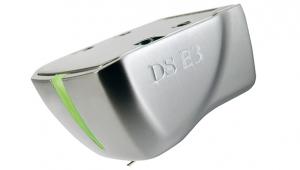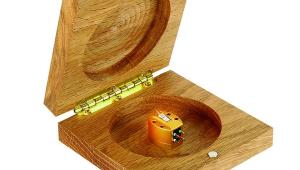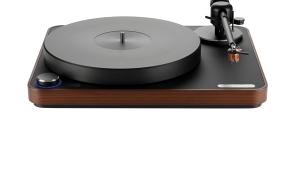Transcriptors Spyder & Audiomods Tonearm (£1250/£895)
From the reborn Transcriptors company comes an all-new turntable with a pedigree, a design that still follows in the footsteps of the classic 1960s and 1970s models

The original Transcriptors Hydraulic Reference turntable was one of audio history’s great style statements. The story of the design and its creator, the late David Gammon, was told in our May ’11 Audio Milestone feature. Transcriptors was reborn in 2000, thanks to David’s oldest son Michael Gammon. Encouraged by American collector Don Sellers, Michael started an information website for enthusiasts. Inundated with enquiries, he soon found himself providing spares and service for Transcriptors owners around the world. Next step was to offer complete turntables again, with an updated Reference as well as the new Spyder reviewed here.
A CHANGE FROM THE NORM
The Spyder comes as standard at £1000 with an aluminium platter carrying five platter weights in the classic Transcriptors manner, but our sample came with a solid acrylic platter: a £250 optional extra. Despite the octopod implications of the name, the 40mm-thick acrylic main chassis resembles a five-lobed star. In the main bearing at its centre the shaft runs in a phosphor bronze bush and has a cupped bottom end which rests on a 3.5mm-diameter ball. At its upper end, the shaft carries a boss with a broad flange to support the platter. A flat-topped, tallerthan- usual record spindle stands around 20mm above the platter surface. (Guessing the intention was to provide for a record clamp, we were told that a clamp would indeed be made available in the future.) Three of the five chassis lobes house the supporting legs, with feet made of Poron, a moderately soft urethane ‘rubber’ material. With appealing symmetry, the other two lobes support the motor housing and the visually-matching arm mount.
Power for the DC motor comes from a small in-line mains power supply via a separate control unit, with 33.3/45 speed switch and screw adjusters for pitch. This unit came built into a generic aluminium box with no legend or logo, giving the impression of a prototype rather than a finished production item. Drive is via a thin round-section jointed belt running around the full diameter of the platter.
MODIFIED ARM – AND HOW
With the Spyder, we received one of the most striking-looking arms you can buy: the Rega-based Audiomods [see boxout]. Ours came complete with a micrometer arm-height adjustment for VTA ‘on the fly’ and with stainless steel counterweights. With cryo-treated cables and arm tube this version costs £895.
Visually, it’s a world away from the unassuming Rega, though its profusion of well-polished metal might seem to hint at the kind of equipment you see from a dentist’s chair. Those holes in the arm tube aren’t put there just to make it look more interesting, but to control or modify the arm tube resonances. Cross-bracing is also added inside the arm tube, in the form of two aluminum discs at one-third and two-thirds of the way along its length.
As for the bearings, the Audiomods conversion makes use of hybrid-ceramic types, ceramic balls in steel races, said to be 40 times as expensive as the standard RB250 ones. It wouldn’t have made sense to try to fit these to the existing Rega bearing carrier and yoke, so new parts were designed which allow the bearings to be correctly adjusted. For the vertical movement bearings, a new aluminium carrier with a silver-steel shaft is pressed into the Rega arm tube. This places the bearings much further apart – spacing them by 41mm instead of 19mm. The bearing yoke is machined from aluminium alloy and the ball races are held in place by removable bearing caps.
Underneath, Audiomods has also redesigned the lateral-movement bearings. These are now closer to the arm yoke, and again there is a wider spacing between the two races, and there is built-in height adjustment for VTA. Using the optional micrometer, you can alter arm height while playing, to a resolution of 0.01mm!
There is no shortage of aftermarket mods for the Rega counterweight and its mounting stub, coupling the weight to the arm in different ways. Audiomods has gone for an aluminium stub, with a retaining screw threaded into the bearing carrier (rather than the armtube). The weight itself is a complex design with lead layers sandwiched between pieces of brass or stainless steel. Only the lead and the nylon locking screw are in contact with the stub.
An additional small rear weight, below the centre line, can be adjusted to set exact tracking force. Dispensing with Rega’s magnetic bias compensator, Audiomods has substituted a traditional thread-and-weight type. One subtlety here is the quadrant around which the thread runs, claimed to allow fi ne-tuning of the relative effect at inner and outer grooves.
MISSING DETAIL
With Benz Glider SL cartridge installed, I settled down to listen. I have to say that unfortunately the performance of the turntable was marred by audible speed fluctuations. This affected the music I listened to in different and sometimes slightly unexpected ways, but I’ll return to this point at the end of the review.
Just to ring the changes, I started listening with Steve Winwood’s ‘While You See A Chance’ on Arc Of A Diver [Island ILPS 9576]. Here the Spyder was quite impressive, sounding robust and conveying the urgency of the beat quite well. But it couldn’t do much to open up the rather airless sound of this recording, and to be critical I felt that there could have been more inner detail.
On Albert King’s Live Wire Blues Power [Stax 1002], the Spyder sounded pleasing and conveyed the atmosphere of the track quite well. Though the bass end was free from boom, there was still a vagueness to the bass guitar sound, which didn’t quite do justice to the player’s work in underpinning the music. King’s voice came over well enough, but there needed to be a little more intimate detail to let you ‘feel’ the performance.
Turning to I Got The Music In Me [Sheffield Lab LAB-2], Thelma Houston’s vocal was exciting, full and punchy, and in the complex sections when the whole band let rip, the record player did a fairly good job of letting you hear the separate strands in the music, allowing the singer and backing vocalists to do their thing.
The bass was, I thought, quite good here, with some sense of ‘moving air’ and a good feeling of attack, again without ever sounding boomy.
Listening to Tracy Chapman [Elektra 960774-2] and ‘Fast Car’, the singer came over quite well but the overall effect was perhaps a little too muted. The bass here was again quite acceptable, weighty not exaggerated or overpowering, although not as well defined or harmonically connected as you could wish.
In the midrange the sound was attractively poised, although in the treble cymbal sounds tended to become a tizz. Drum sounds generally, I felt, were not particularly impressive, even on what should be the dramatic kick-in into the chorus, here appearing a little slurred rather than crisp.
With Eric Clapton’s Backless [RSO Deluxe RSD5001], the Spyder responded fairly well to the complex, grungy mix of ‘Walk Out In The Rain,’ but left the vocal sounding weedy and indistinct. On ‘Watch Out For Lucy,’ the beat seemed merely relentless, rather than joyfully swinging, perhaps because of subtle losses of precision and detail with the bass and drum.After this track comes the moody ‘I’ll Make Love To You Anytime,’ where the bottom-heavy mix seemed too much for the system to open up, and consequently the music starting to descend into a dull thudding monotony.
A more modern recording, ‘Time In A Bottle’ from Christine Collister’s Love [Rega ENS 002] was a little disappointing too, as I felt that the nuances of the singer’s personal sound weren’t captured very well, and didn’t seem to be presented with crisp, fine detail.
Finally I moved on to some classical music, and the familiar English String Music with Sir John Barbirolli and the Sinfonia of London and Allegri Quartet [EMI ASD 521], starting with Elgar’s Introduction and Allegro. Here the Spyder produced a bright and initially persuasive view of the music. As it went on, though, I felt that the sense of space was too easily lost, the massed strings sometimes appearing too tensely frenetic, with a blurring of subtle detail and a tendency to become muzzy.
A SICKENING FEELING
Returning to the speed/pitch issue, I’d heard a prominent cyclical fluctuation when using the 300Hz tones on an HFS 75 test record to check the cartridge set-up. Real music doesn’t consist of continuous tones of a single frequency, and speed problems may be obvious on some music and yet be almost unnoticed on others. For example, wow was obvious on the repeated piano chords and then also on the long-held notes from the horns in ‘I Got The Music In Me.’ With Tracy Chapman’s ‘Fast Car,’ a pitch wobble was obvious on the guitar intro.Even quite gross speed variations aren’t always heard directly as a change in pitch. The late Angus McKenzie (who used to write for HFN) used to say that wow made him feel seasick, and I think that describes what happened with Barbirolli’s strings, for example. On rock or pop records, pitch problems can make musicians sound tentative, weedy or plain amateurish.
As we go to press, Transcriptors is making running production changes to both platter and bearing. We wish this famous marque every success and will report on any updates.
VERDICT
This new model from a famous old name looks appealing, though with the solid-platter option its ancestry is not so apparent. Unfortunately, while the sound was promising, it was seriously affected by poor speed stability, and probably could not do justice to the intriguing Audiomods arm. For inveterate tweakers for whom the Rega donor is simply too ‘plug and play’, the latter is commended in its own right .
Originally published in the November 2011 issue


























































